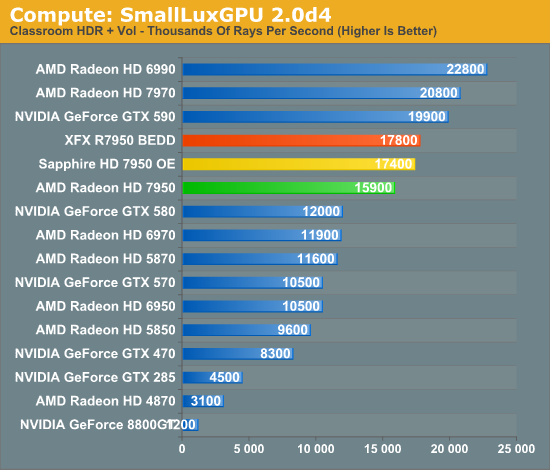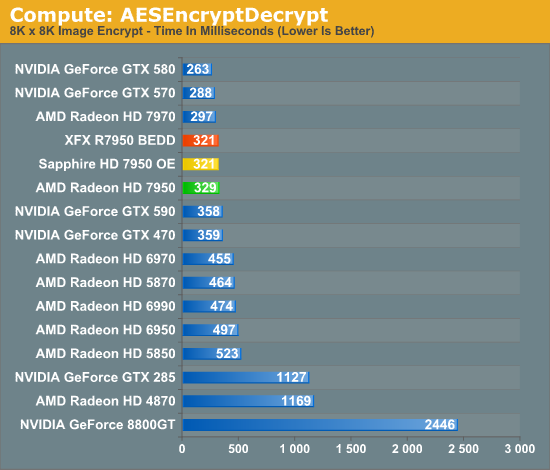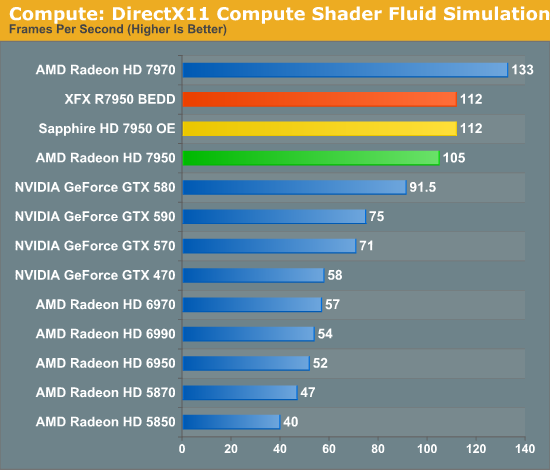AMD Radeon HD 7950 Review Feat. Sapphire & XFX: Sewing Up The High-End Market
by Ryan Smith on January 31, 2012 9:02 AM ESTCompute Performance
Moving on from our look at gaming performance, we have our customary look at compute performance. Since compute performance is by definition shader bound, the 7950 is at a bit of a disadvantage here compared to gaming performance. Whereas ROP performance scales with the core clock, shader performance is hit by both the reduction in the core clock and the disabled CU array.
Our first compute benchmark comes from Civilization V, which uses DirectCompute to decompress textures on the fly. Civ V includes a sub-benchmark that exclusively tests the speed of their texture decompression algorithm by repeatedly decompressing the textures required for one of the game’s leader scenes. Note that this is a DX11 DirectCompute benchmark.

AMD’s greatly improved compute performance continues to shine here, though in the case of Civilization V it’s largely consumed by just closing the previously large gap between the GTX 500 series and the Radeon HD 6000 series. As a result the 7950 falls ever so short of the GTX 580, while the factory overclocked Sapphire and XFX cards give the 7950 enough of a push to come within 5% of the 7970.
Our next benchmark is SmallLuxGPU, the GPU ray tracing branch of the open source LuxRender renderer. We’re now using a development build from the version 2.0 branch, and we’ve moved on to a more complex scene that hopefully will provide a greater challenge to our GPUs.

Under SmallLuxGPU the 7970 enjoyed a large lead over the GTX 580, and this continues with the 7950. Even though the 7950 is well behind the 7970—to the tune of 24%—it’s still 33% ahead of the GTX 580 and the lead only grows from there. Meanwhile the XFX and Sapphire cards can catch up to the 7970 somewhat, but as this is truly a shader-bound test, you can’t make up for the lack of shaders units on the 7950.
For our next benchmark we’re looking at AESEncryptDecrypt, an OpenCL AES encryption routine that AES encrypts/decrypts an 8K x 8K pixel square image file. The results of this benchmark are the average time to encrypt the image over a number of iterations of the AES cypher.

In spite of being a compute benchmark, AESEncryptDecrypt is not particularly sensitive to GPU performance, showcasing the impact that setup times can have. The 7950 trails the 7970 by 10%, and overclocking doesn’t change this much. Unfortunately for AMD NVIDIA is still the leader here, showing that AMD’s compute performance still has room to grow.
Finally, our last benchmark is once again looking at compute shader performance, this time through the Fluid simulation sample in the DirectX SDK. This program simulates the motion and interactions of a 16k particle fluid using a compute shader, with a choice of several different algorithms. In this case we’re using an (O)n^2 nearest neighbor method that is optimized by using shared memory to cache data.

With the compute shader fluid simulation we once again shift back into a compute task that’s much more shader-bound. The 7950 only reaches 80% of the performance of the 7970, once more proving the real impact of losing a CU array. This is still enough to handily surpass the GTX 580 however, with the 7950 taking a 15% lead.










259 Comments
View All Comments
xeridea - Tuesday, January 31, 2012 - link
Tru Datxeridea - Tuesday, January 31, 2012 - link
But not as bad as the Obamination we are in today.bji - Tuesday, January 31, 2012 - link
Which is better than the Bush clusterf** we were in yesterday ...Sabresiberian - Tuesday, January 31, 2012 - link
Too bad we can't actually blame stupidity on some drug that we can prevent people from smoking.;)
dagamer34 - Tuesday, January 31, 2012 - link
So you want to wag your finger at AMD for trying to make money when Nvidia has decided not to show up for a few months? Everyone knows that competition drives lower prices and right now AMD doesn't have any at the truly high end. If you want the parts now, you can pay up or wait. It's that simple.I am actually glad AMD is competing at the truly high end again because it shows confidence in their products. Confident products = bolder designs in the long term.
chizow - Tuesday, January 31, 2012 - link
Actually I've been saying for years AMD missed an opportunity to profit by mispricing their RV770 badly. Ever since that time they've been trying to dig themselves out of the pricing mistake they caused, because as a direct result, Nvidia dropped their flagship single-GPU prices to $350-400 for the 2nd tier and $500 for the top single gpu. Since AMD's subsequent parts have always trailed Nvidia's same-gen parts, they were obviously forced to price their cards according to Nvidia's performance, which generally meant $400 or less.The problem is that SI offers none of the performance and value you would expect from a next-gen part, nor does it raise the bar for price/performance. It only manages to keep the status quo using last-gen metrics and the 7950 is direct proof of this. Its roughly the same price and performance as the GTX 580, which would've been great if this were 2010 when the GTX 580 launched, but its 2012 now.
arjuna1 - Tuesday, January 31, 2012 - link
leave it to an nvidia fanboy to twist facts around as needed to put nvidia on top.chizow - Tuesday, January 31, 2012 - link
I didn't say Nvidia was on top...But honestly, as an ATI fan take a look at the 6970 results compared to the 7950 and then ask yourself if you really think the 7950 is worth the price at $450-500 compared to the $300-350 for a 6970....
I mean if you thought the 6970 was a great deal compared to the GTX 580 how on earth could you think the 7950 is some amazing bargain some 14 months later?
Galidou - Tuesday, January 31, 2012 - link
OMG and you just realized that? Welcome in 2012, you hav ebeen sleeping for the last 20 years?!?Video card manufacturers have done that a thousand times before... Nvidia and Ati with their rebranding and next gen higher priced than last gen for the same performance... The top segment was never meant to be performance/price top of the chart.... OMG.
So by listening to what you said from the beginning, anything below gtx 580 is useless, because you can find last gen video card lower priced for more or same performance, because of the next-gen price premium... HELLO!?! wake up...
You can find gtx 480's at a way lower price than gtx 570's on the bay for about the same performance...
You can find radeon 4870 about half the price of 6770's for about the same performance....
And so on....
chizow - Tuesday, January 31, 2012 - link
I don't think you understand that in your attempt to discredit my point, you've actually completely validated it.Yes, historically when a new part releases it compresses prices and forces older last-gen parts to drop in price as the new price:performance metrics dictate a drop in price with the next-gen level of performance.
None of this is occurring with SI because AMD has priced this part exactly where its performance lies because they are basing this on last-gen metrics. If anything, lower tier parts are probably UNDER priced relative to performance compared to SI and have no reason to drop in price.